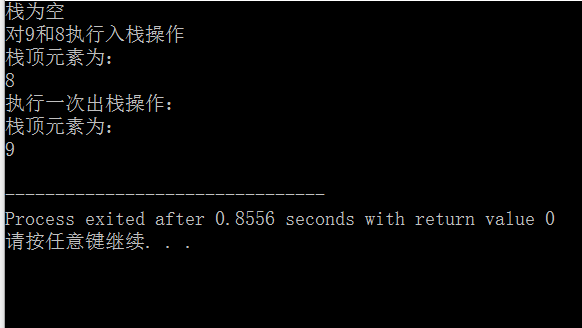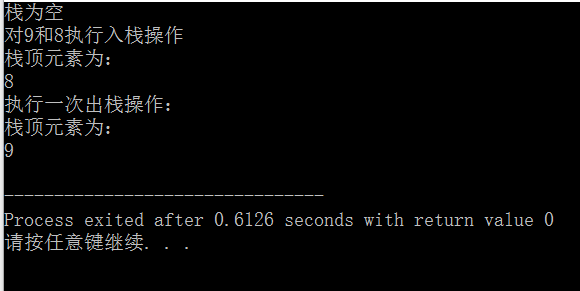顺序栈和链栈的基本操作
2017-10-16 13:40
363 查看
一、实验目的
1、 熟练掌栈的结构特点,掌握栈的顺序存储和链式存储结构和实现。
2、 学会使用栈解决实际问题。
二、实验内容
自己确定结点的具体数据类型和问题规模:
分别建立一个顺序栈和链栈,实现栈的压栈和出栈操作。
三、实验代码
1.顺序栈的源代码

3.链栈的源代码
#include <iostream>
using namespace std;
template<class DataType>
struct Node
{
DataType data;
Node<DataType>*next;
};
template<class DataType>
class LinkStack
{
public:
LinkStack(){top=new Node<DataType>; top=NULL;};
~LinkStack(){};
void Push(DataType x);
DataType Pop();
DataType GetTop();
int Empty();
private:
Node<DataType>*top;
};
template<class DataType>
void LinkStack<DataType>::Push(DataType x)
{
Node<DataType>*s;
s=new Node<DataType>;
s->data=x;
s->next=top;
top=s;
}
template<class DataType>
DataType LinkStack<DataType>::Pop()
{
DataType x;
if(top==NULL)throw"下溢";
else
{
Node<DataType>*p;
p=new Node<DataType>;
p=top;
x=p->data;
top=top->next;
delete p;
return x;
}
}
template<class DataType>
DataType LinkStack<DataType>::GetTop()
{
if (top!=NULL);
return top->data;
}
template<class DataType>
int LinkStack<DataType>::Empty()
{
if(top==NULL)return 1;
else return 0;
}
int main()
{
LinkStack<int>S;
if(S.Empty())
cout<<"栈为空"<<endl;
else
cout<<"栈非空" <<endl;
cout<<"对9和8执行入栈操作"<<endl;
S.Push(9);
S.Push(8);
cout<<"栈顶元素为:"<<endl;
cout<<S.GetTop()<<endl;
cout<<"执行一次出栈操作:"<<endl;
S.Pop();
cout<<"栈顶元素为:"<<endl;
cout<<S.GetTop()<<endl;
} 4.链栈的实验结果

四、心得
这次实验我通过查阅书上的资料和向同学提问,最终操作并调试出了顺序栈和链栈的代码。在调试的过程中仍然会遇到很多细节上的错误,比如少加了分号,或者是打错符号等细节上的错误,也会有一些是声明与定义上的错误,通过自己的查找与同学的提示最终修改成功,基本掌握了顺序栈和链栈的操作。
1、 熟练掌栈的结构特点,掌握栈的顺序存储和链式存储结构和实现。
2、 学会使用栈解决实际问题。
二、实验内容
自己确定结点的具体数据类型和问题规模:
分别建立一个顺序栈和链栈,实现栈的压栈和出栈操作。
三、实验代码
1.顺序栈的源代码
const int StackSize=10;
template<class DataType>
class SeqStack
{
public:
SeqStack();
~SeqStack(){};
void Push(DataType x);
DataType Pop();
DataType GetTop();
int Empty();
private:
DataType data[StackSize];
int top;
};
template<class DataType>
SeqStack<DataType>::SeqStack()
{
top=-1;
}
template<class DataType>
void SeqStack<DataType>::Push(DataType x)
{
if(top==StackSize-1)throw"上溢";
top++;
data[top]=x;
}
template<class DataType>
DataType SeqStack<DataType>::Pop()
{
DataType x;
if(top==-1)throw"下溢";
x=data[top--];
return x;
}
template<class DataType>
DataType SeqStack<DataType>::GetTop()
{
if (top!=-1)
return data[top];
}
template<class DataType>
int SeqStack<DataType>::Empty()
{
if(top==-1)return 1;
else return 0;
}
#include <iostream>
using namespace std;
int main()
{
SeqStack<int>S;
if(S.Empty())
cout<<"栈为空"<<endl;
else
cout<<"栈非空" <<endl;
cout<<"对9和8执行入栈操作"<<endl;
S.Push(9);
S.Push(8);
cout<<"栈顶元素为:"<<endl;
cout<<S.GetTop()<<endl;
cout<<"执行一次出栈操作:"<<endl;
S.Pop();
cout<<"栈顶元素为:"<<endl;
cout<<S.GetTop()<<endl;
}2.顺序栈的实验结果
3.链栈的源代码
#include <iostream>
using namespace std;
template<class DataType>
struct Node
{
DataType data;
Node<DataType>*next;
};
template<class DataType>
class LinkStack
{
public:
LinkStack(){top=new Node<DataType>; top=NULL;};
~LinkStack(){};
void Push(DataType x);
DataType Pop();
DataType GetTop();
int Empty();
private:
Node<DataType>*top;
};
template<class DataType>
void LinkStack<DataType>::Push(DataType x)
{
Node<DataType>*s;
s=new Node<DataType>;
s->data=x;
s->next=top;
top=s;
}
template<class DataType>
DataType LinkStack<DataType>::Pop()
{
DataType x;
if(top==NULL)throw"下溢";
else
{
Node<DataType>*p;
p=new Node<DataType>;
p=top;
x=p->data;
top=top->next;
delete p;
return x;
}
}
template<class DataType>
DataType LinkStack<DataType>::GetTop()
{
if (top!=NULL);
return top->data;
}
template<class DataType>
int LinkStack<DataType>::Empty()
{
if(top==NULL)return 1;
else return 0;
}
int main()
{
LinkStack<int>S;
if(S.Empty())
cout<<"栈为空"<<endl;
else
cout<<"栈非空" <<endl;
cout<<"对9和8执行入栈操作"<<endl;
S.Push(9);
S.Push(8);
cout<<"栈顶元素为:"<<endl;
cout<<S.GetTop()<<endl;
cout<<"执行一次出栈操作:"<<endl;
S.Pop();
cout<<"栈顶元素为:"<<endl;
cout<<S.GetTop()<<endl;
} 4.链栈的实验结果

四、心得
这次实验我通过查阅书上的资料和向同学提问,最终操作并调试出了顺序栈和链栈的代码。在调试的过程中仍然会遇到很多细节上的错误,比如少加了分号,或者是打错符号等细节上的错误,也会有一些是声明与定义上的错误,通过自己的查找与同学的提示最终修改成功,基本掌握了顺序栈和链栈的操作。
